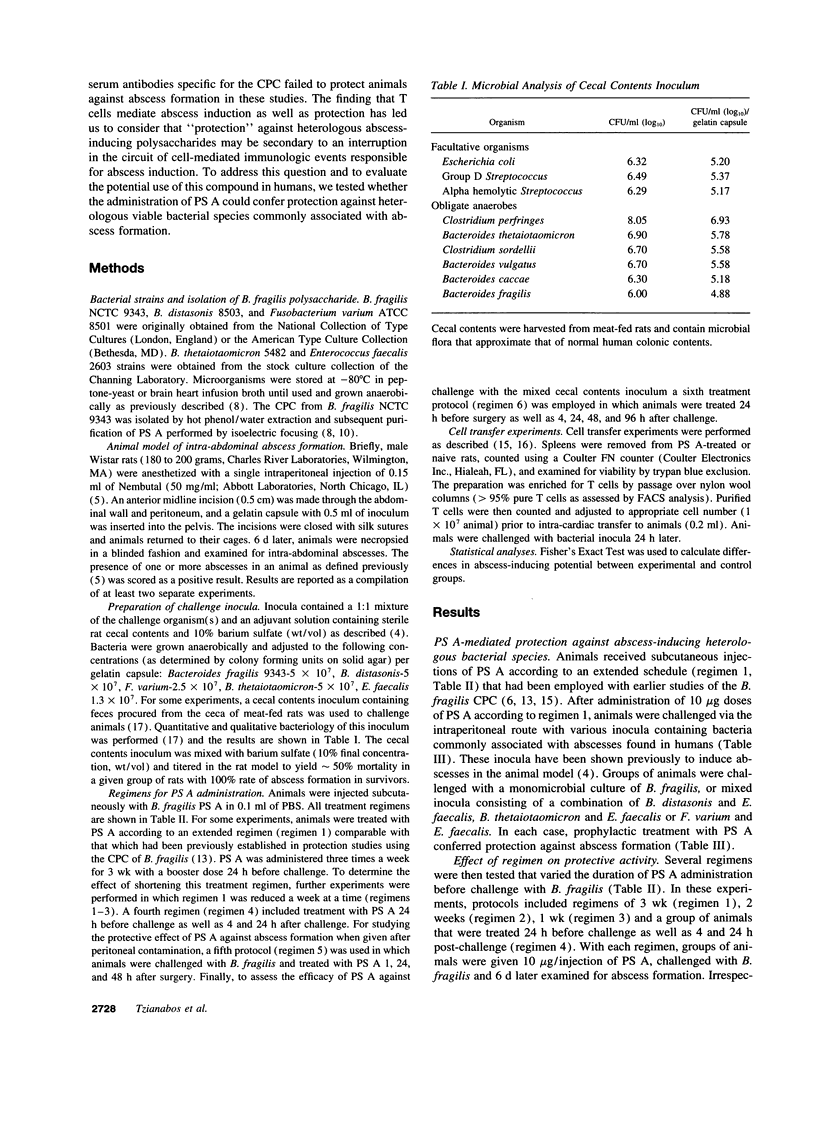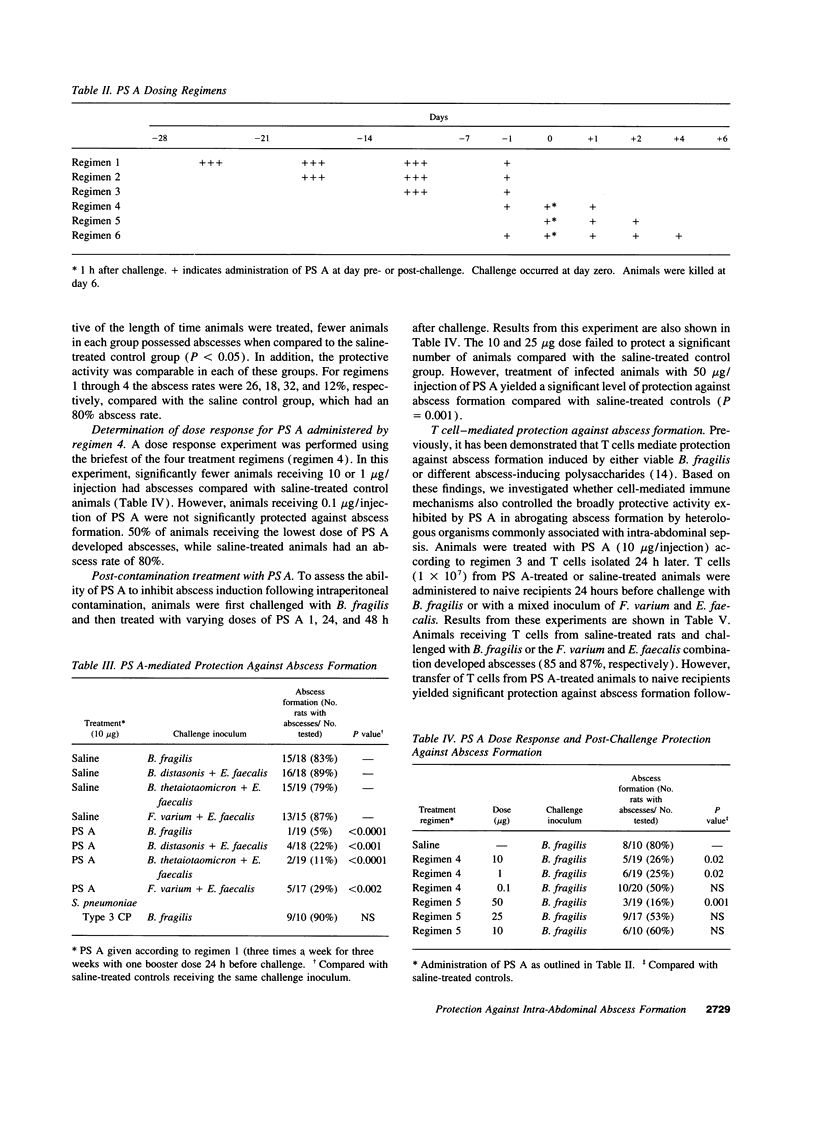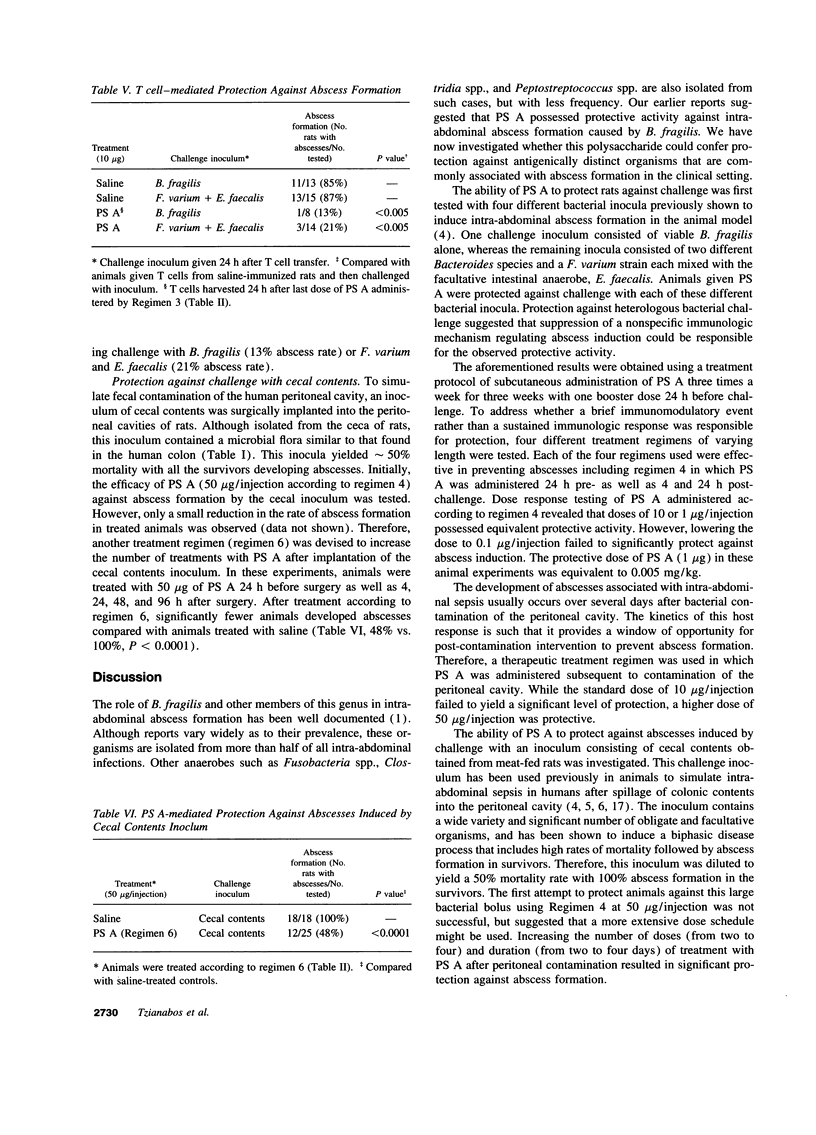Abstract
Abscess formation is a major complication of intra-abdominal sepsis that causes significant morbidity and mortality. In such cases, Bacteroides fragilis is the predominant anaerobic isolate. In a rat model of intra-abdominal sepsis, the capsular polysaccharide complex (CPC) from B. fragilis promotes abscess formation and when administered sub-cutaneously, protects against this host response by a T cell-dependent immune mechanism. In the present study, the polysaccharide A (PS A) component of CPC protected animals against challenge with live heterologous bacterial species (mixtures of anaerobes and facultative organisms) that are most commonly isolated from intra-abdominal abscesses in humans. Protection against heterologous bacterial challenge was transferred by T cells. Administration of PS A shortly before or even after challenge with B. fragilis protected against this host response. In experiments designed to simulate fecal contamination of the human peritoneal cavity, PS A protected animals against abscess formation induced by a rat cecal contents inoculum. The surprisingly broad protective activity of PS A indicates that this molecule is likely suppressing a nonspecific host tissue reaction that forms in response to a variety of abscess-inducing organisms and that it might be useful in preventing abscess formation associated with intra-abdominal sepsis in the clinical setting.
Full text
PDF




Selected References
These references are in PubMed. This may not be the complete list of references from this article.
- Baumann H., Tzianabos A. O., Brisson J. R., Kasper D. L., Jennings H. J. Structural elucidation of two capsular polysaccharides from one strain of Bacteroides fragilis using high-resolution NMR spectroscopy. Biochemistry. 1992 Apr 28;31(16):4081–4089. doi: 10.1021/bi00131a026. [DOI] [PubMed] [Google Scholar]
- Gorbach S. L., Bartlett J. G. Anaerobic infections. 1. N Engl J Med. 1974 May 23;290(21):1177–1184. doi: 10.1056/NEJM197405232902106. [DOI] [PubMed] [Google Scholar]
- Kasper D. L., Onderdonk A. B., Crabb J., Bartlett J. G. Protective efficacy of immunization with capsular antigen against experimental infection with Bacteroides fragilis. J Infect Dis. 1979 Nov;140(5):724–731. doi: 10.1093/infdis/140.5.724. [DOI] [PubMed] [Google Scholar]
- Nichols R. L. Intraabdominal infections: an overview. Rev Infect Dis. 1985 Nov-Dec;7 (Suppl 4):S709–S715. doi: 10.1093/clinids/7.supplement_4.s709. [DOI] [PubMed] [Google Scholar]
- Onderdonk A. B., Bartlett J. G., Louie T., Sullivan-Seigler N., Gorbach S. L. Microbial synergy in experimental intra-abdominal abscess. Infect Immun. 1976 Jan;13(1):22–26. doi: 10.1128/iai.13.1.22-26.1976. [DOI] [PMC free article] [PubMed] [Google Scholar]
- Onderdonk A. B., Kasper D. L., Cisneros R. L., Bartlett J. G. The capsular polysaccharide of Bacteroides fragilis as a virulence factor: comparison of the pathogenic potential of encapsulated and unencapsulated strains. J Infect Dis. 1977 Jul;136(1):82–89. doi: 10.1093/infdis/136.1.82. [DOI] [PubMed] [Google Scholar]
- Onderdonk A. B., Markham R. B., Zaleznik D. F., Cisneros R. L., Kasper D. L. Evidence for T cell-dependent immunity to Bacteroides fragilis in an intraabdominal abscess model. J Clin Invest. 1982 Jan;69(1):9–16. doi: 10.1172/JCI110445. [DOI] [PMC free article] [PubMed] [Google Scholar]
- Onderdonk A. B., Weinstein W. M., Sullivan N. M., Bartlett J. G., Gorbach S. L. Experimental intra-abdominal abscesses in rats: quantitative bacteriology of infected animals. Infect Immun. 1974 Dec;10(6):1256–1259. doi: 10.1128/iai.10.6.1256-1259.1974. [DOI] [PMC free article] [PubMed] [Google Scholar]
- Pantosti A., Tzianabos A. O., Onderdonk A. B., Kasper D. L. Immunochemical characterization of two surface polysaccharides of Bacteroides fragilis. Infect Immun. 1991 Jun;59(6):2075–2082. doi: 10.1128/iai.59.6.2075-2082.1991. [DOI] [PMC free article] [PubMed] [Google Scholar]
- Pantosti A., Tzianabos A. O., Reinap B. G., Onderdonk A. B., Kasper D. L. Bacteroides fragilis strains express multiple capsular polysaccharides. J Clin Microbiol. 1993 Jul;31(7):1850–1855. doi: 10.1128/jcm.31.7.1850-1855.1993. [DOI] [PMC free article] [PubMed] [Google Scholar]
- Polk B. F., Kasper D. L. Bacteroides fragilis subspecies in clinical isolates. Ann Intern Med. 1977 May;86(5):569–571. doi: 10.7326/0003-4819-86-5-569. [DOI] [PubMed] [Google Scholar]
- Shapiro M. E., Kasper D. L., Zaleznik D. F., Spriggs S., Onderdonk A. B., Finberg R. W. Cellular control of abscess formation: role of T cells in the regulation of abscesses formed in response to Bacteroides fragilis. J Immunol. 1986 Jul 1;137(1):341–346. [PubMed] [Google Scholar]
- Shapiro M. E., Onderdonk A. B., Kasper D. L., Finberg R. W. Cellular immunity to Bacteroides fragilis capsular polysaccharide. J Exp Med. 1982 Apr 1;155(4):1188–1197. doi: 10.1084/jem.155.4.1188. [DOI] [PMC free article] [PubMed] [Google Scholar]
- Tzianabos A. O., Onderdonk A. B., Rosner B., Cisneros R. L., Kasper D. L. Structural features of polysaccharides that induce intra-abdominal abscesses. Science. 1993 Oct 15;262(5132):416–419. doi: 10.1126/science.8211161. [DOI] [PubMed] [Google Scholar]
- Tzianabos A. O., Onderdonk A. B., Zaleznik D. F., Smith R. S., Kasper D. L. Structural characteristics of polysaccharides that induce protection against intra-abdominal abscess formation. Infect Immun. 1994 Nov;62(11):4881–4886. doi: 10.1128/iai.62.11.4881-4886.1994. [DOI] [PMC free article] [PubMed] [Google Scholar]
- Tzianabos A. O., Pantosti A., Baumann H., Brisson J. R., Jennings H. J., Kasper D. L. The capsular polysaccharide of Bacteroides fragilis comprises two ionically linked polysaccharides. J Biol Chem. 1992 Sep 5;267(25):18230–18235. [PubMed] [Google Scholar]
- Zaleznik D. F., Finberg R. W., Shapiro M. E., Onderdonk A. B., Kasper D. L. A soluble suppressor T cell factor protects against experimental intraabdominal abscesses. J Clin Invest. 1985 Mar;75(3):1023–1027. doi: 10.1172/JCI111763. [DOI] [PMC free article] [PubMed] [Google Scholar]


